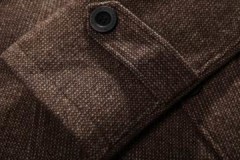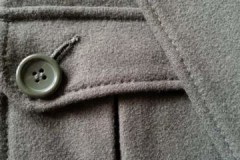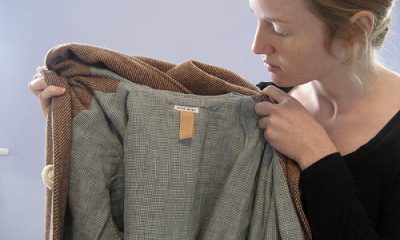 In order for the coat to always have a flawless look, constant care is required. Especially if the product is made in light colors or has a bright finish.
In order for the coat to always have a flawless look, constant care is required. Especially if the product is made in light colors or has a bright finish.
Dry cleaning services are expensive and there is a risk of paying for poor quality work. A profitable alternative is to wash yourself.
In order not to spoil the style of the coat and the structure of the fabric during the washing process, you must follow the rules specific to the individual material.
How to wash a coat by hand so that it does not get hooked, what happens if you wash the product in an automatic washing machine? Details are in the article.
Content
Can the coat be washed at home?
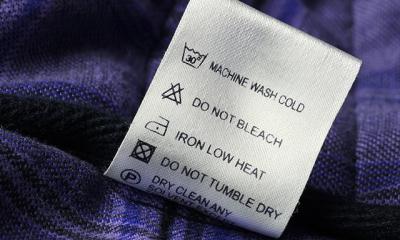 If the coat is made of a fabric where the presence of natural fibers exceeds 60%, you should refuse to wash at home, otherwise the thing will lose its shape, stretch or, conversely, shrink.
If the coat is made of a fabric where the presence of natural fibers exceeds 60%, you should refuse to wash at home, otherwise the thing will lose its shape, stretch or, conversely, shrink.
Also, you cannot wash products made of fine camel wool, leather, suede or models with large inserts of these materials, otherwise the coat will be hopelessly damaged.
To avoid a fatal mistake, you should carefully study the signs on the label with instructions from the manufacturer:
- If there is a square mark with a circle inside, crossed out with two lines, it means that automatic washing is prohibited.
- The presence of a crossed-out basin on the tag indicates that the item cannot be washed by hand. In this case, only dry cleaning is possible.
The detergent will definitely not cope with the stain, it is better to immediately take the thing to dry-cleaner - the services of specialists will cost less than buying a new coat.
Preparation for the procedure
When the manufacturer indicates on the tag that washing is permissible, you can get down to business. First of all, you need to determine in what way to wash - in a washing machine or by hand.
When choosing, it should be borne in mind that hand washing is always more delicate than in a washing machine, in which the fabric is subjected to more severe wear.
To prepare a garment for washing, you should:
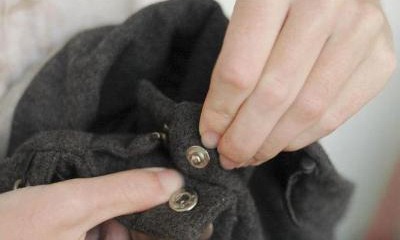 remove all items from pockets;
remove all items from pockets;- fasten all buttons, zippers, snaps and other fasteners.
- unfasten or whip the existing fur;
- if available, also remove the removable hood and lining so that small areas in the fastening points do not remain contaminated;
- Remove any existing stains with a stain remover or suitable detergents, choosing them according to the type of fabric.
Apply the solution to the contaminated area with a cotton swab and leave for 7-10 minutes, then rinse thoroughly with water.
In a washing machine
If the label indicates that the fabric contains more than 50% synthetic fibers, the coat can be washed in the washing machine.
In this case, the following rules must be observed:
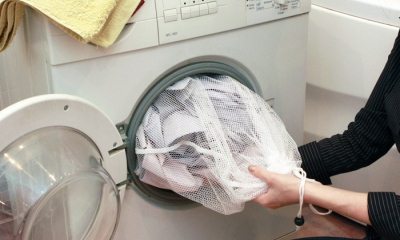 first fold the product into a special net so that the washing process becomes safer for the fabric (you should not tamp the coat too much, just fold the floors, align the sleeves along the silhouette and fold it in 2 times);
first fold the product into a special net so that the washing process becomes safer for the fabric (you should not tamp the coat too much, just fold the floors, align the sleeves along the silhouette and fold it in 2 times);- do not put other things on the coat, as they may shed during washing, or strongly deform the fabric;
- use only liquid detergents for a specific material, since the powder leaves white traces (you can also use universal mixtures "Down products", "For soft fabrics", etc.);
- set the water temperature to 30-40 C, usually it is indicated on the tag;
- put only a delicate wash cycle that matches the type of fabric;
- even if the manufacturer allows spinning, it is better to do without it, which will allow the material to last longer;
- always use an extra rinse to ensure a good result.
When washing use the amount of detergent indicated on the packaging... Excess will only add streaks to the fabric, and the quality of the wash will not increase.
Features for different fabrics
When washing a coat automatically, you must take into account the characteristics of the fabric. Putting a thing into the drum of a typewriter should be done only if there is a permit sign on the product label.
It is not recommended to pre-soak coat - prolonged exposure to water spoils the style of the product.
It is also necessary to take into account the color of the material, and choose special detergents for black or colored fabrics that are able to maintain the saturation of the colors.
From the drape
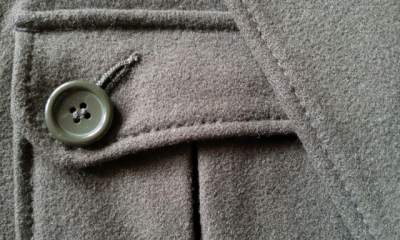 The drape is made of natural woolen fibers or with the addition of synthetic threads - the composition of the material is indicated on the coat label. Natural drape cannot be wetted, it can only be cleaned with a soft brush.
The drape is made of natural woolen fibers or with the addition of synthetic threads - the composition of the material is indicated on the coat label. Natural drape cannot be wetted, it can only be cleaned with a soft brush.
If the drape contains mainly artificial fibers, it is allowed to machine wash the coat at a water temperature of +30 C, using the “hand wash” program or a delicate cycle at low speeds. Avoid spinning and double rinse.
Details about the drape coat and its care are described in a separate article.
Cashmere
Cashmere is made from mountain goat down, so this material is especially delicate and capricious. If the coat says 70-100% cashmere, it should never be immersed in water at all.
High-end washing machines have a mode specifically for cashmere... If there is no such function, you need to choose a delicate method and put water at + 30C.
In the event that the coat just needs to be freshened, you can also wash it in cold water using a washing gel specifically for this material.
You can find out more about washing a cashmere coat in a special section.
From wool
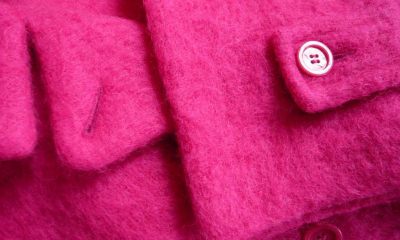 Wool comes in many varieties... Fabrics such as boston, tweed, reps and bouclé are made from sheep's wool. It looks like dense fabrics, but when immersed in water they become elastic.
Wool comes in many varieties... Fabrics such as boston, tweed, reps and bouclé are made from sheep's wool. It looks like dense fabrics, but when immersed in water they become elastic.
Therefore, if more than 50% of natural elements are indicated on the label, they cannot be washed, only cleaned.
The presence of synthetic threads in the fabric of 50% or more makes the fabric more durable and wear-resistant - such wool can be washed in a washing machine.
It is necessary to set a delicate wash cycle with the inscription "wool", and scroll at a water temperature of + 30C. Do not spin, only rinse at low speed.
Features of washing wool coats are described in detail here.
Polyester
Polyester is a synthetic material made up of polyester fibers. Products made from it are practical, durable and hardly wrinkle. A coat made of this fabric can be safely put into the washing machine.
Polyester in hot water loses a lot in volume, the fibers of the fabric lose their strong structure, so it must be washed in a delicate mode. You can use the "spin" function, but set no more than 400 revolutions.
Be sure to add a mild conditioner to your liquid detergent to help remove static electricity from the fabric.
On padding polyester
Sintepon is a non-woven material that is a synthetic insulation:
- It can be washed only in warm water (+ 30-40 C), in the “delicate” or “hand wash” modes.
- It is absolutely impossible to soak things on a padding polyester.
- Do not use a spin, it is better to set a double rinse.
From holofiber
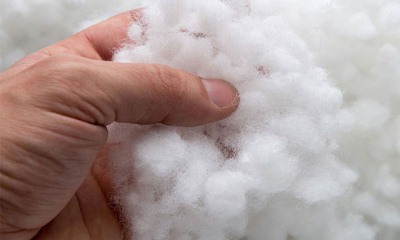 Holofiber is an improved filler with a more porous structure than sintepon. He is less capricious in leaving.
Holofiber is an improved filler with a more porous structure than sintepon. He is less capricious in leaving.
If it is heavily soiled, it can be washed in hot water (up to +60 C), spinning up to 600 rpm. If the coat just needs to be freshened up, it is better to save the fabric and wash in warm water +30 C.
To prevent the filler from rolling, put 3-4 balls in the drum for washing... Make sure the paint on the balls does not fade before use.
Mixed composition
If the coat has a mixed composition, its components are detailed on the product label. For washing, the “hand wash” or delicate function is usually recommended.
The water temperature should be set no higher than +30 C, and the spin should be turned off... You need to rinse such a coat at low speed.
A padded polyester coat should not be washed frequently. During the washing process, the water-repellent impregnation is washed out, which leads to a loss of strength of the synthetic fiber. In this case, the coat quickly gets wet and loses its style.
How to hand wash at home?
If the sign on the label showed that washing in a washing machine is prohibited, use the manual method.
For this choose a container that is suitable for the size - the coat should be completely immersed in water and not strongly shrink, then the product is washed evenly and there will be no extra creases.
Hand wash procedure:
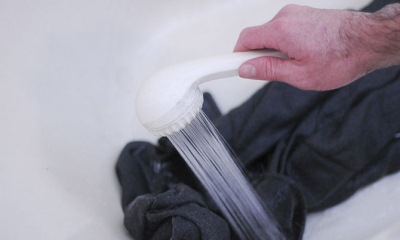 Pour a sufficient amount of warm water into the container (not higher than +30 C).
Pour a sufficient amount of warm water into the container (not higher than +30 C).- Add the amount of liquid detergent indicated on the packaging and mix thoroughly.
- Immerse the product in prepared water so that it gets completely wet.
- Slightly squeeze the fabric over the entire area with gentle movements (you cannot rub the dirty areas intensively, otherwise pellets will appear, and the color of the material may also change).
- Wash quickly so that the garment is in soapy water for as little time as possible.
- After washing, rinse immediately, trying to move the coat out of the basin without stretching it.
- Rinse with plenty of cool water without pulling the coat to the surface, otherwise the thing may deform.
How to dry properly?
The automatic dryer can only be used for down filled polyester coats. Together with the product, wash balls must be placed in the drum so that the fluff is evenly distributed in the cells. Dry for no longer than 1.5 hours at a temperature of +30 C.
We recommend drying models made from other fabrics as follows:
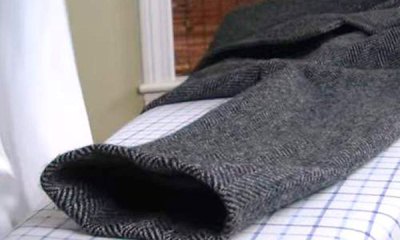 prepare a suitable horizontal drying platform and cover it with a soft, fading cloth;
prepare a suitable horizontal drying platform and cover it with a soft, fading cloth;- lay out the product evenly, straightening the creases and wait for the water to drain;
- after an abundant runoff of water, transfer the coat also horizontally onto a dry, dense cloth (a terry sheet or a large towel will do), smoothing all the details with your hands;
- choose the right place for drying - it should be a spacious warm room with good ventilation (you cannot leave it in the bathroom, there the thing will acquire a musty smell);
- when the coat becomes slightly damp, it can be hung on a hanger and kept away from heating appliances;
- drying in the fresh air is allowed in warm weather up to +18 C (not in the heat), without direct sunlight;
- finish drying on time, if necessary, iron the thing with a warm iron through cheesecloth or thin fabric (the coat cannot be overdried, in this case the thing is guaranteed to shrink and the material will lose its smoothness).
If the product shrinks after washing - what to do?
The main causes of coat shrinkage after home washing are:
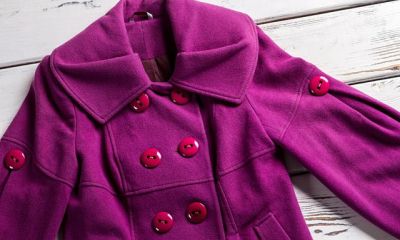 wrong choice of detergent;
wrong choice of detergent;- washing without taking into account the characteristics of the material;
- water hotter than permissible (must be within +30 C);
- a sharp temperature drop (when the water during washing is much warmer than when rinsing);
- automatic or manual aggressive spinning;
- violation of the rules of drying.
If mistakes have already been made and the coat has decreased in size, there are ways to return it to its original appearance:
- Method number 1... You will need such a solution: for 5 liters of warm water (+ 15-20 C) 2 tbsp. spoons of soda. Pour enough solution into a basin of a suitable size so that the coat is completely immersed. Hold the product for 30 minutes, then rinse thoroughly in water of the same temperature.
Lay out the item horizontally, without squeezing, and gently pull it out to the desired size. Repeat gentle stretching during the drying process, and when the material becomes barely wet, steam well and dry vertically, hanging on a hanger.
- Method number 2... For him you need such a mixture: for 10 liters of cold water - 6 tbsp. tablespoons of ammonia and 5 tbsp. tablespoons of turpentine. Mix the ingredients well and place the coat in there for 40 minutes. This solution perfectly softens fabric fibers and makes them elastic.
After the procedure, rinse the item thoroughly also in cold water and spread it horizontally. After 10 minutes, pull out the coat, repeating the manipulation until it is completely dry, and then, if necessary, iron it through a thin cloth.
- Method number 3... This method is good for delicate cashmere and fine wool. Stir hair conditioner in cold water (10 liters will need 2 tablespoons). Hold the shrunken coat in this mixture for 25-30 minutes, then rinse in cool water.
Lay out on a horizontal surface, do not wring out the fabric. Then smooth out the product with your hands and begin to pull it out first in breadth, and then along the fibers. Repeat stretching periodically until the end of drying.
How to avoid further shrinkage
 Such deformation of the fabric, such as shrinkage, negatively affects the appearance of the product, and it is not easy to eliminate it. The advantage of dry cleaning is that they return the product to the desired size using an inflatable dummy..
Such deformation of the fabric, such as shrinkage, negatively affects the appearance of the product, and it is not easy to eliminate it. The advantage of dry cleaning is that they return the product to the desired size using an inflatable dummy..
The thing is put on it and, as it dries, the right amount of air is added, and then thoroughly steamed.
In household use, a simple mannequin is a rarity. Therefore, in order to avoid further shrinkage of the coat, you should not act at random when washing, but carefully study the features of the material from which this model is made.
Useful information on washing outerwear is provided in this section.
Conclusion
To wash your coat well at home, you need to choose the right way of washing, the right detergent, follow the rules washing and drying this type of fabric and take into account all the recommendations of the manufacturer.
If you take the process seriously, then a good result is guaranteed.
